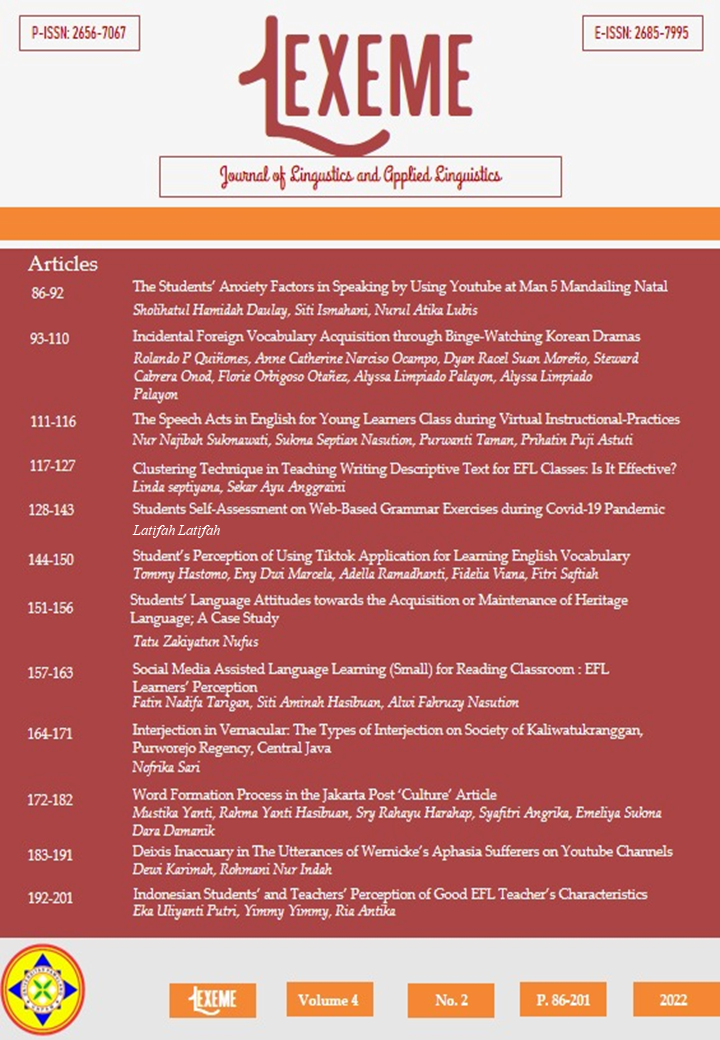INCIDENTAL FOREIGN VOCABULARY ACQUISITION THROUGH BINGE-WATCHING KOREAN DRAMAS
DOI:
https://doi.org/10.32493/ljlal.v4i2.19055Keywords:
K-Drama, incidental vocabulary acquisition, subtitlesAbstract
From reading activities to media consumption, studies about incidental vocabulary acquisition have progressed through the “germination and molding stages and have emerged to a comprehensive development stage†(Tang, 2020). Given that one of the established productive instructional tools that can help in expanding a learner’s language skill is watching subtitled foreign films (Kabooha, 2016), the researchers investigated the relationship between binge-watching Korean Drama Series and the incidental vocabulary acquisition of tertiary level learners in the Polytechnic University of the Philippines. The researchers used a non-experimental correlational approach to measure the degree of relationship that exists between the two variables. The results show that the respondents are considered 'moderately knowledgeable' on the specific Korean words and phrases on the survey questionnaire based on the weighted mean response of their Korean Vocabulary Depth. Hence, there is a significant relationship between binge-watching habits of the respondents and their Basic Korean Vocabulary Knowledge Depth. The researchers also concluded that as the binge-watching habits increase, the Basic Korean Vocabulary Knowledge Depth also increases.
References
Allado, K., Peñol, A., & Bachiller, D. (2016). I learn Korean my way: A case study. International Journal on Studies in English Language and Literature. 4(1), 42-52. https://www.arcjournals.org/pdfs/ijsell/v4-i1/6.pdf.
Almeida, P. A., & Costa, P. D. (2014). Foreign language acquisition: The role of subtitling. Procedia - Social and Behavioral Sciences, 141, 1234–1238. https://doi.org/10.1016/j.sbspro.2014.05.212
Bardakçı, M. (2016). Breadth and depth of vocabulary knowledge and their effects on L2 vocabulary profiles. English Language Teaching, 9(4), 239–250. https://doi.org/10.5539/elt.v9n4p239
Bartlett, F. C. (1932). Remembering: A study in experimental and social psychology. Cambridge: Cambridge University Press
Bergania, T. (2019, August 28). Essential words and phrases you should know if you’re a K-Drama newbie. Cosmo.ph. https://www.cosmo.ph/entertainment/essential-words-phrases-for-k-drama-newbies-a968-20190601-lfrm?fbclid=IwAR2hpAi-ICCWPLkmiGuNM409E7-sNoVb69v9teVyVu9tYNaMs6YUjmBjTJQ
Birulés-Muntané, J., & Soto-Faraco, S. (2016). Watching subtitled films can help learning foreign languages. PLOS ONE, 11(6). https://doi.org/10.1371/journal.pone.0158409
Bisson, M. J., van Heuven, W. J. B., Conklin, K., & Tunney, R. J. (2013). Incidental acquisition of foreign language vocabulary through brief Multi-Modal exposure. PLOS ONE, 8(4), e60912. https://doi.org/10.1371/journal.pone.0060912
Chapman, R. (2017). The role of subtitles in language teaching. Annali Online di Ferrara Lettere 12(1), 2-15. https://doi.org/10.15160/1826-803x/1479
De Benedittis (2016) Korean Language for Beginners. https://www.spdbooks.org/Content/Site106/FilesSamples/9781624120688.pdf
Dewaele, J. M. (2008). “Appropriateness†in foreign language acquisition and use: Some theoretical, methodological and ethical considerations. IRAL - International Review of Applied Linguistics in Language Teaching, 46(3). https://doi.org/10.1515/iral.2008.011
Flayelle, M., Maurage, P., di Lorenzo, K. R., Vögele, C., Gainsbury, S. M., & Billieux, J. (2020). Binge-Watching: What do we know so far? A first systematic review of the evidence. Current Addiction Reports, 7(1), 44–60. https://doi.org/10.1007/s40429-020-00299-8
FluentU Korean Language and Culture Blog. (2017, January 11). How to radically improve your Korean by learning with subtitles. https://www.fluentu.com/blog/korean/learn-korean-subtitles/
Foreign Service Institute. (2020, December 1). Foreign language training. United States Department of State. https://www.state.gov/foreign-language-training/
Globibo Language School. (n.d.). Korean language courses. Retrieved September 2, 2021, from http://www.language-school.hk/Korean-language-courses.php
Harji, M. B., Woods, P. C., & Alavi, Z. K. (2010). The effect of viewing subtitled videos on vocabulary learning. Journal of College Teaching & Learning (TLC), 7(9), 37–42. https://doi.org/10.19030/tlc.v7i9.146
Haastrup, K., & Henriksen, B. (2000). Vocabulary acquisition: Acquiring depth of knowledge through network building. International Journal of Applied Linguistics, 10(2), 221–240. https://doi.org/10.1111/j.1473-4192.2000.tb00149.x
Hulstijn, J. H. (2013). Incidental learning in second language acquisition. In C. A. Chapelle (Ed.), The encyclopedia of applied linguistics (Vol. 5). Wiley-Blackwell. https://doi.org/10.1002/9781405198431.wbeal0530
Igno, J., & Cenidoza, M. (2016). Beyond the “fadâ€: Understanding hallyu in the Philippines. International Journal of Social Science and Humanity, 6(9), 723–727. https://doi.org/10.18178/ijssh.2016.6.9.740
Kabooha, R. H. (2016). Using movies in EFL classrooms: A study conducted at the english language institute (ELI), king Abdul-Aziz university. English Language Teaching, 9(3), 248. https://doi.org/10.5539/elt.v9n3p248
Koyfman, S. (2021, January 21). How to use movies to learn a language. Babbel Magazine. https://www.babbel.com/en/magazine/use-foreign-movies-for-language-learning
Korean Explorer Language School. (2018, April 4). Can you really learn the Korean language from K-dramas? https://www.koreanexplorer.com.sg/articles/can-you-really-learn-the-korean-language-from-k-dramas/
Korean Language Guide. (2017, March 30). Easiest way to learn Korean for women: Watch K-drama. https://www.koreanlanguageguide.com/easiest-way-to-learn-korean-for-women-watch-k-drama/
Kuppens, A. (2010). Incidental foreign language acquisition from media exposure. Learning, Media and Technology, 35(1), 65–85. https://doi.org/doi:10.1080/17439880903561876
Lekkai, I. (2014). Incidental foreign-language acquisition by children watching subtitled television programs. TOJET: The Turkish Online Journal of Educational Technology, 13(4). 81–87. https://eric.ed.gov/?id=EJ1043240
Liu, M., & Huang, W. (2011). An exploration of foreign language anxiety and english learning motivation. Education Research International, 1–8. https://doi.org/10.1155/2011/493167
Nagy, W. E., Herman, P. A., & Anderson, R. C. (1985). Learning words from context. Reading Research Quarterly, 20(2), 233. https://doi.org/10.2307/747758
Official Gazette of the Republic of the Philippines. (2021, February 11). Omnibus guidelines on the implementation of community quarantine in the Philippines with amendments as of February 11, 2021 | GOVPH. https://www.officialgazette.gov.ph/2021/02/11/omnibus-guidelines-on-the-implementation-of-community-quarantine-in-the-philippines-with-amendments-as-of-february-11-2021/
Parry, K. (1991). Building a vocabulary through academic reading. TESOL Quarterly, 25(4), 629–652.
Pavia, N., Webb, S., & Faez, F. (2019). Incidental vocabulary learning through listening to songs. Studies in Second Language Acquisition, 41(04), 1–24. https://doi.org/10.1017/s0272263119000020
Pearson correlation coefficient: Introduction, formula, calculation, and examples. (n.d.) QuestionPro. https://www.questionpro.com/blog/pearson-correlation-coefficient/
Peters, E., & Webb, S. (2018). Incidental vocabulary acquisition through viewing L2 television and factors that affect learning. Studies in Second Language Acquisition, 40(3), 551–577. https://doi.org/10.1017/s0272263117000407
Pittman, M., & Sheehan, K. (2015). Sprinting a media marathon: Uses and gratifications of binge-watching television through Netflix. First Monday. Published. https://doi.org/10.5210/fm.v20i10.6138
Rahul, D. R., & Ponniah, J. (2020). Understanding the robustness of incidental vocabulary acquisition through reading: Qualitative insights from biolinguistics. Rupkatha Journal on Interdisciplinary Studies in Humanities, 12(5), 1–12. https://doi.org/10.21659/rupkatha.v12n5.rioc1s23n2
Reynolds, B. L. (2014). Evidence for the task-induced involvement construct in incidental vocabulary acquisition through digital gaming. The Language Learning Journal, 45(4), 466–484. https://doi.org/10.1080/09571736.2014.938243
Saragi, T., Nation, I., & Meister, G. (1978). Vocabulary learning and reading. System, 6(2), 72–78. https://doi.org/10.1016/0346-251x(78)90027-1
Selinker, L. (1972). Interlanguage. International Review of Applied Linguistics in Language Teaching, 10:3 p.209
Schmitt, N. (2010). Researching vocabulary: A vocabulary research manual. Palgrave Macmillan. https://doi.org/10.1057/9780230293977
Sta. Maria, T. (2020, May 8). 15 easy korean words & phrases every K-Drama fan should know! [PART ONE]. TripZilla. https://www.tripzilla.com/korean-phrases-for-k-drama-fans/109914?fbclid=IwAR3ZK7LZWIiSHIjAOQXY3P-YxhVUI9Mf3beHBWoSMXnsV1yNGPysCu9Rz4A
Tangpos, A. (2018). How have Korean dramas influenced Philippine industry? Grant Thornton Philippines. https://www.grantthornton.com.ph/insights/articles-and-updates1/line-of-sight/how-have-korean-dramas-influenced-philippine-industry/
Teng, F. (2016). The effects of word exposure frequency on incidental learning of the depth of vocabulary knowledge. GEMA Online® Journal of Language Studies, 16(3), 53–70. https://doi.org/10.17576/gema-2016-1603-04
Van Zeeland, H., & Schmitt, N. (2013). Lexical coverage in L1 and L2 listening comprehension: The same or different from reading comprehension? Applied Linguistics, 34(4), 457–479. https://doi.org/10.1093/applin/ams074
Vanderplank, R. (2016). Captioned media in foreign language learning and teaching: Subtitles for the deaf and Hard-of-Hearing as tools for language learning, (1st ed.). Palgrave Macmillan.
Vidal, K. (2003). Academic listening: A source of vocabulary acquisition? Applied Linguistics, 24(1), 56–86
Villanueva, J. (2017). Impact of popular culture on tourism: A study on the influence of watching Korean dramas to female UPLB students’ desire to travel to South Korea. University of the Philippines Los Baños. https://www.researchgate.net/publication/317339106
Wang, Q. (2020). Incidental L2 vocabulary acquisition and reading: Concerns, progresses and future directions. Chinese Journal of Applied Linguistics, 43(4), 469–488. https://doi.org/10.1515/cjal-2020-0031
Webb, S. (2008). The effects of repetition on vocabulary knowledge. Applied Linguistics, 28(1), 46–65. https://doi.org/10.1093/applin/aml048
Wesche, M., & Paribakht, T. S. (1996). Assessing second language vocabulary knowledge: Depth versus breadth. Canadian Modern Language Review, 53(1), 13–40. https://doi.org/10.3138/cmlr.53.1.13







